Recognized internationally for her multi-dimensional artwork using diverse media, Mary Beth Edelson has been a dominant force in feminist groups and actions since the 1960s. Her prominence in, and significant contributions to, the feminist art world make Edelson an ideal selection for The Feminist Institute’s mission to “be the world’s most significant online repository for the study of feminist documentation.”
This Feminist Institute project on Edelson highlights the depth of artistic production and historical documentation that is found in her archives now in the Fales Library and Special Collections at New York University. This feature presents a selection from the artist’s decades-long collecting of material on feminist events, exhibitions, panels, projects, collaborations, brochures, letters, and photographs—mostly the countless images Edelson took herself—but also her own drawings, collages, artist books, and more.
Born in 1933, Mary Beth Edelson majored in Art at DePauw University and received her MA at New York University. Throughout the late 1950s and 1960s, she was politically active and gave her first lecture on the lack of opportunities for women artists in 1968 at the Herron Art Museum. Edelson moved to Washington, D.C., in 1968, where she organized the first National Conference for Women in the Visual Arts in 1972. Alongside early paintings such as the installation “Goddess Tribe” (1974-75) constructed from life-sized, painted plywood cutouts shown at the Henri Gallery in Washington, D.C. in 1975, Edelson created numerous private ritual performances most often nude in nature such as the “Woman Rising” series (1973), “Moon Mouth” (1973), and “Goddess Head” (1975) in which she took the photographic prints of these actions and marked their surfaces with various materials. She became more involved in performance and participatory art as in her “Story Gathering Boxes” begun in 1972, and performative photographic work especially after settling in New York in 1975. It was during this decade that Edelson made some of her best-known early works such as the group performance “Proposals for Memorials to 9,000,000 Women Burned as Witches in the Christian Era” (1977) at A.I.R. Gallery and the private performance “Grapceva Neolithic Cave Series: See for Yourself” (1977). After moving to New York, Edelson was invited to join A.I.R. Gallery and later became a founding member of the Heresies Collective in 1977.
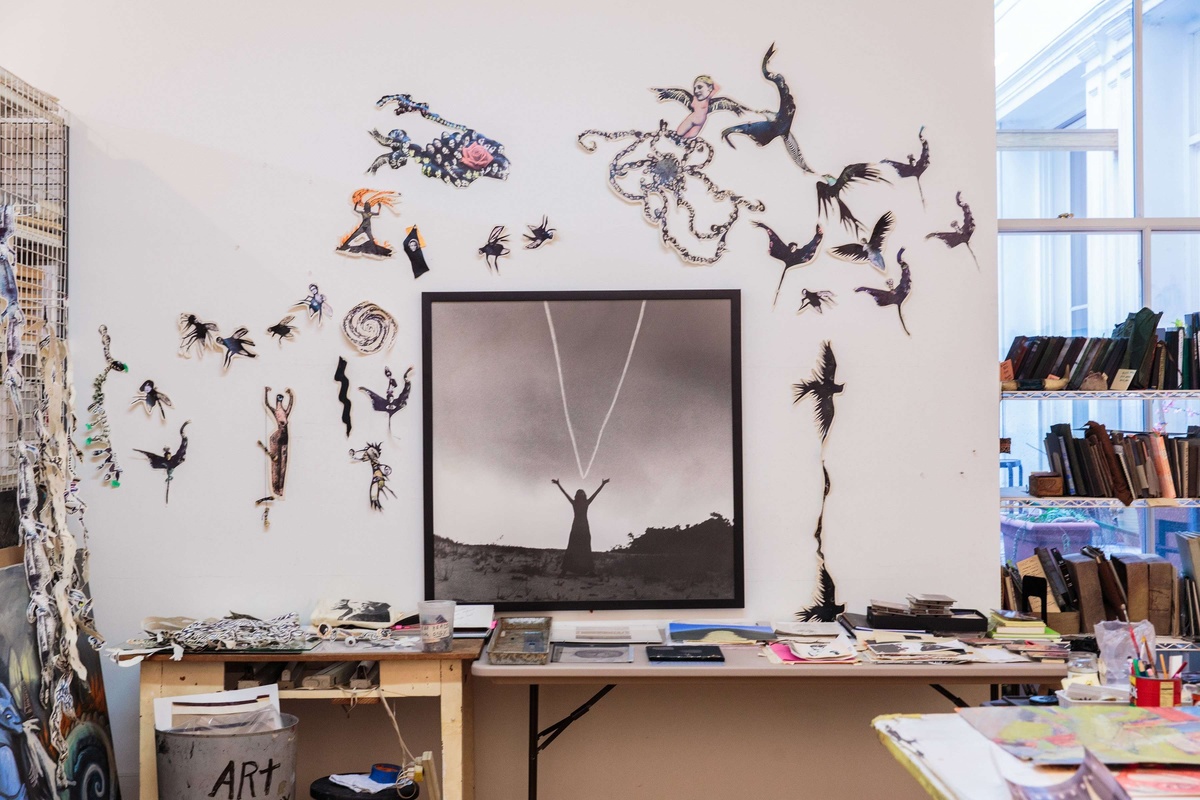
Photo credit: Kolin Mendez
Edelson almost always carried her Hasselblad or Nikon camera to feminist art events, shooting images of the activities and those involved in the events, but she also took headshots of women artists who were active in the community. These photographs were resources, most notably for the series of five collaged posters from the 1970s that began with “Some Living American Women Artists/Last Supper” (1971-72) and the numerous wall collages that covered her studio walls and were included in exhibitions in the United States and abroad. The themes found in the wall collages that Edelson created since the 1970s parallel with those in her prolific body of work including ancient goddesses, Sheela-Na-Gig, Baubo, Medusa, Venus, snakes, movie stars, stereotypes, beauty, mythology, humor, and a celebration of her feminist colleagues.
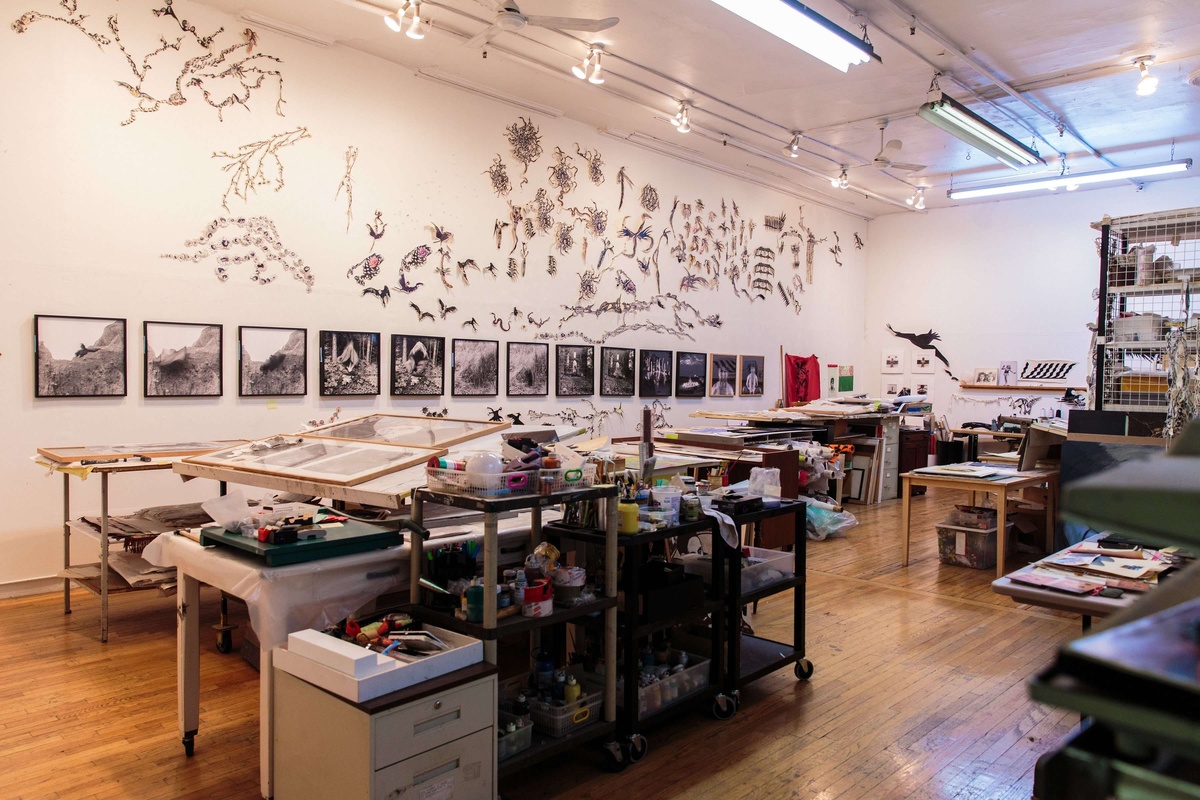
Photo credit: Kolin Mendez
Edelson’s work ranges from small detailed wall collages to room-encompassing installations. Starting in 1985, Edelson embarked on large wall painting projects such as “Shape Shifters” (1988) in Washington, DC and “Dear Correspondent” (1988) in Saskatchewan, the latter incorporated community and audience input. Alongside the large-scale installations, Edelson made numerous drawing, watercolors, mechanical transfers, and silkscreens on canvas throughout the 1980s. In the 1990s the artist engages with stereotypes of women stemming from film and popular culture manipulating images of Peggy Cummins, Gena Rowlands, Mae West, Marilyn Monroe, and Sigourney Weaver, among others, many of whom sling guns. For these images Edelson uses a silkscreen process combined with oil, watercolor, ink, pencil, and fabric. These images are extended to a series of large chiffon installations such as “Already Marked” (1997/98) with an image of Gloria Graham from The Big Heat. Edelson was concerned with a number of issues in these works including how female subjectivity is presented in film and popular culture, the role of the femme fatales, and humor as a way to disrupt the social order.
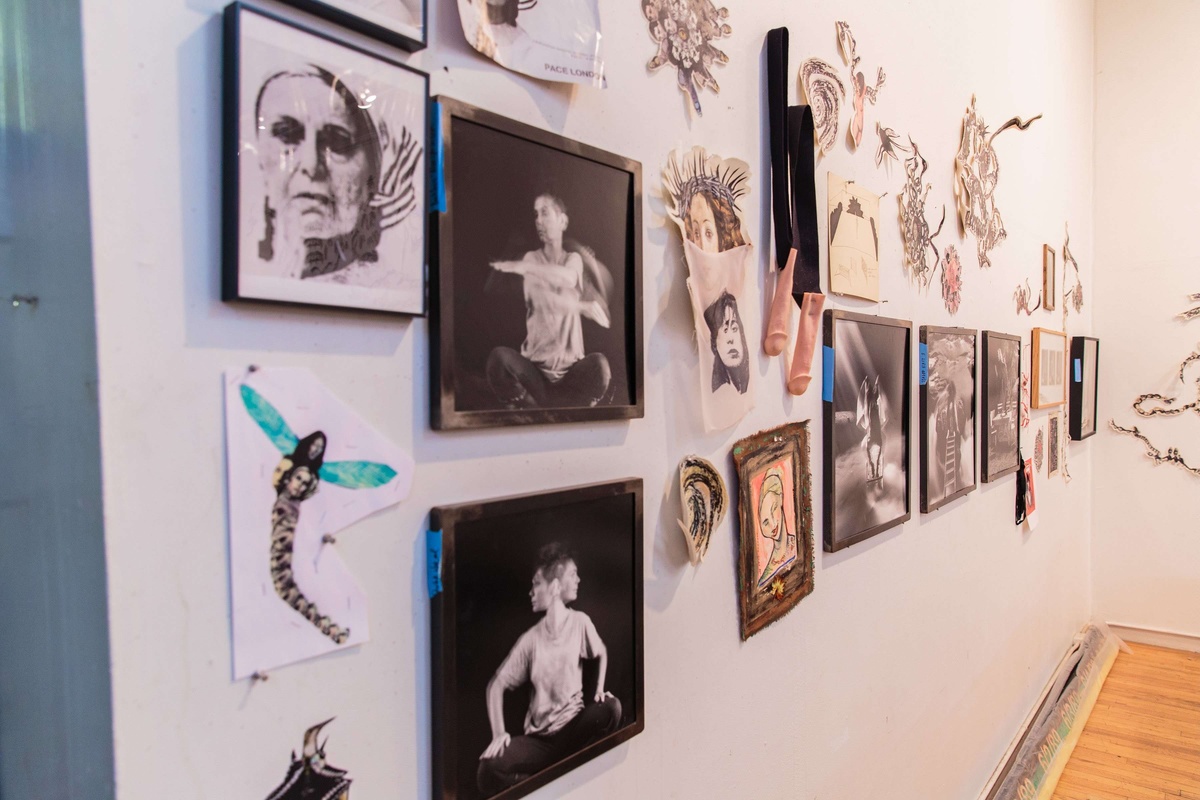
Photo credit: Kolin Mendez
In the 1980s and 1990s, Edelson also continued with her private performative photographic works that include the “Backlash” (1985) series taken in Port Clyde, Maine and others taken in upstate New York such as “Staged Exit,” High Falls, NY (1992) and “Springing Traps: Diversity Replacing Duality,” the Widow Jane Cave, Rosendale, NY (1992). Edelson also started making sculptures especially in bronze in 1983 that included images of the Sheela-Na-Gig and other forms based on materials found in nature and the urban landscape. Anyone who had the opportunity to visit Edelson’s dynamic studio could not have missed the numerous rat sculptures!
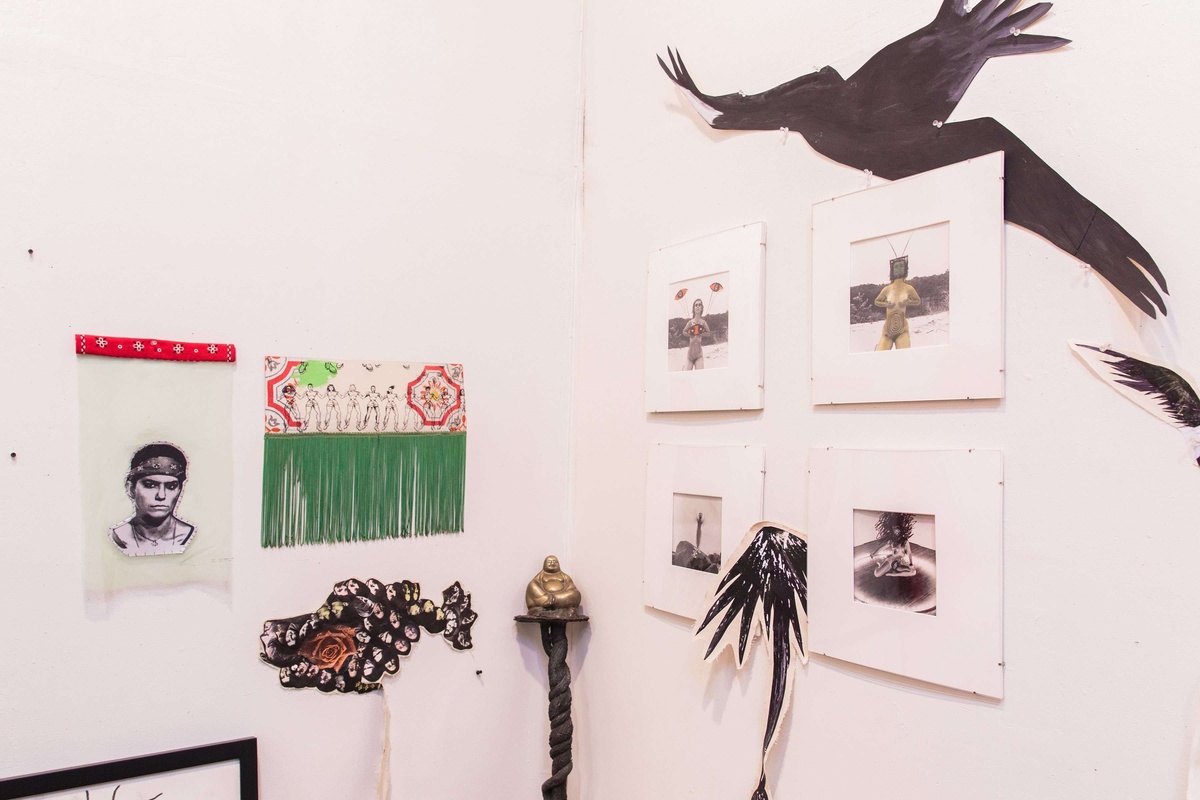
Photo credit: Kolin Mendez
Throughout her life, Edelson’s activist work permeated her artistic production and vis versa. For her performance and activist work, she frequently used her studio as a space for such work inviting others there to collaborate, especially on the various activist causes in which she was involved such as the Women’s Action Coalition (WAC, founded in 1992) and “Combat Zone: Campaign HQ Against Domestic Violence” (1994), a three-month long project to assist victims of domestic violence in self-defense that became a model for similar programs around the country. Throughout the 1990s her work was included in numerous exhibitions and publications is the US and Europe that included the broad range of her work.
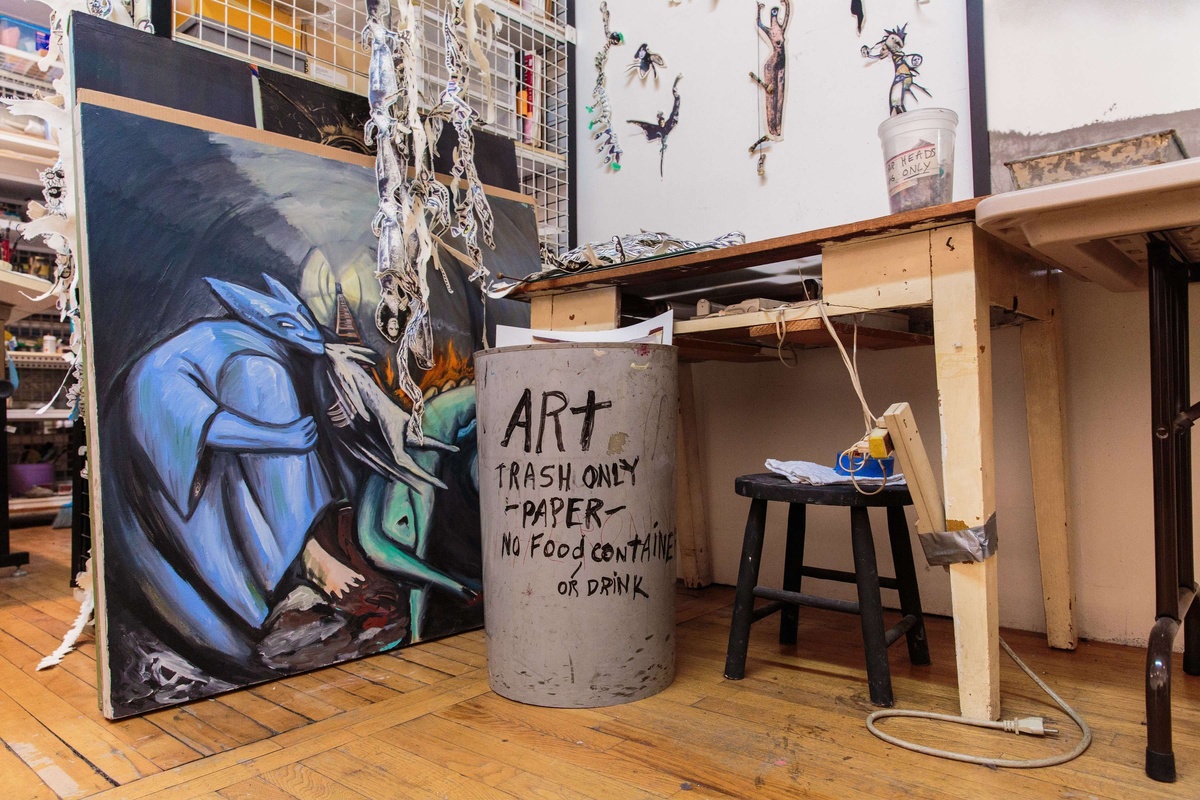
Photo credit: Kolin Mendez
In the first two decades of the 2000s, there is a widespread recognition of feminist art as a significant aspect of avant-garde art activity as evidenced in numerous high-profile exhibitions. Edelson had her own shows such as “Mary Beth Edelson: A Well Lived Life” (2006) at the Malmö Konstmuseum in Sweden and her work was included in the “Greater New York” exhibition held at MoMA PS1 in 2015. She was also invited to contribute to larger retrospective surveys on feminist art such as “It’s Time for Action (There’s No Option). About Feminism” (2007) at the Migros Museum für Gegenwartskunst in Zurich; “WACK! Art and the Feminist Revolution” (2007) at the Museum for Contemporary Art in Los Angeles that travelled to Washington, DC, New York, and Vancouver; and “Feminist Avant-Garde: Art of the 1970s, The SAMMLUNG VERBUND Collection, Vienna” that travelled throughout Europe from 2010 through 2019.
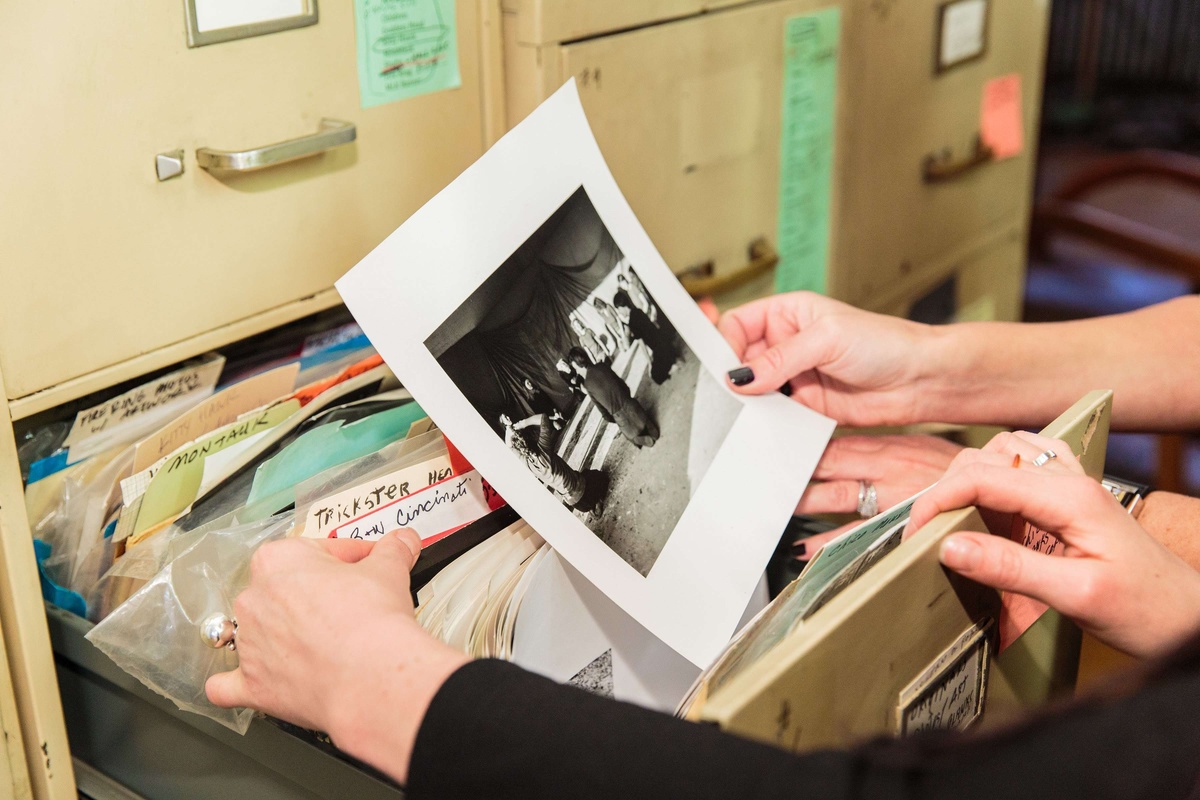
Photo credit: Kolin Mendez
“[I exclaim to make] a political statement for women that says I am, and I am large, and I am my body, and I am not going away.”
Mary Beth Edelson, 1980.
Throughout Edelson’s prolific career, she has created drawings, paintings, collages, sculptures, performances, photographs, installations, interactive works, and group performances alongside her commitment to activist causes and to her fellow artists. She thought of things in the collective, bringing women together to create or accomplish a set of goals. In describing the “Woman Rising” series Edelson stated that “these photographic images were defining images—not who I am but who we are” and at the same time wanted her artistic community of women to share and feel empowered by her work through which she exclaimed to make “a political statement for women that says I am, and I am large, and I am my body, and I am not going away.” (Edelson, 1980, 17)
Written by Dr. Kathleen Wentrack
© 2019 Kathleen Wentrack
Kathleen Wentrack, PhD, is a Professor of Art History at The City University of New York, Queensborough CC and the editor of the forthcoming book “Collaboration, Empowerment, Change: Women’s Art Collectives.” She recently published “1970s Feminist Practice as Heterotopian: The Stichting Vrouwen in de Beeldende Kunst and the Schule für kreativen Feminismus,” in “All Women Art Spaces in the Long 1970s” edited by Agata Jakubowska and Katy Deepwell (Liverpool University Press, 2018). She is a contributing editor to Art History Teaching Resources and Art History Pedagogy and Practice and a co-coordinator of The Feminist Art Project in New York City.
Produced by Erica Galluscio
Photography of studio space provided by Kolin Mendez Photography
Accola Griefen Fine Art exhibition photos courtesy of Accola Griefen Fine Art: Rob van Erve
Images of “Goddess Tribe” installation courtesy of David Lewis New York
Select Bibliography
Buszek, Maria Elena. “Mothers and Daughters, Sluts and Goddesses: Mary Beth Edelson and Annie Sprinkle.” In: It’s Time for Action (There’s No Option). About Feminism. Ed. Heike Munder. Zurich: Migros Museum für Gegenwartskunst and JRP/Ringier, 2007, 228-61.
Edelson, Mary Beth. The Art of Mary Beth Edelson. New York: Seven Cycles, 2002.
Edelson, Mary Beth. Firsthand: Photographs by Mary Beth Edelson, 1973-1993 and Shooter Series. Essay by Jan Avgikos, “No Reverse Gear.” Mary Beth Edelson: New York, 1993.
Edelson, Mary Beth. Interview with Kathleen Wentrack. New York, 12 September 2008.
Edelson, Mary Beth. “Male Grazing: An Open Letter to Thomas McEvilley.” In: Feminism-Art-Theory: An Anthology, 1968-2000.” Ed. Hilary Robinson. Oxford: Blackwell, 2001, 592-94. First published as “Objections of a ‘Goddess Artist:’ An open Letter to Thomas McEvilley.” New Art Examiner 16, No. 8 (April 1989): 34-38.
Edelson, Mary Beth. “Pilgrimage/See for Yourself: A Journey to a Neolithic Goddess Cave, 1977. Grapceva, Hvar Island Yugoslavia.” Heresies: A Feminist Publication of Art and Politics #5, Spring 1978: 96-99.
Edelson. Mary Beth. Seven Cycles: Public Rituals. With an Introduction by Lucy R. Lippard.” New York: Mary Beth Edelson, 1980.
Edelson. Mary Beth. Shape Shifter: Seven Mediums. New York: Mary Beth Edelson, 1990.
Edelson. Mary Beth. “Success Has 1,000 Mothers: Art and Activism from Mary Beth Edelson’s Point of View.” In: Women’s Culture in a New Era: A Feminist Revolution? Ed. Gayle Kimball. Lanham, Maryland: The Scarecrow Press, 2005, 27-60..
Freitag, Barbara. Sheela-Na-Gigs: Unraveling an Enigma. London: Routledge, 2004
Gimbutas, Marija. Gods and Goddess of Old Europe, 7000 to 3500 BC/Myths, Legends, and Cult Images. Berkeley: University of California Press, 1974.
Griefen, Kat. “Considering Mary Beth Edelson’s Some Living American Women Artists.” The Brooklyn Rail, March 2019, 38-9.
Höglinger, Nora. “Mary Beth Edelson: “The Goddess is Us.” In: Feminist Avant-Garde: Art of the 1970s, The Sammlung Verbund Collection, Vienna. Ed. Gabriele Schor. Munich: Prestel Verlag, 2016, 120-25.
Mesopotamian Gods and Goddesses. Ed. Vincent Hale and Vincent Croce. New York: Britannica Educational Publishing and Rosen Publishing Group, 2014.
Stone, Merlin. When God Was a Woman. New York: Dial Press, 1976.
Wack! Art and the Feminist Revolution. Ed. Lisa Gabrielle Mark. Los Angeles: The Museum of Contemporary Art, 2007.
Winifred Milius Lubell, The Metamorphosis of Baubo: Myths of Women’s Sexual Energy, Nashville and London: Vanderbilt University Press, 1994

